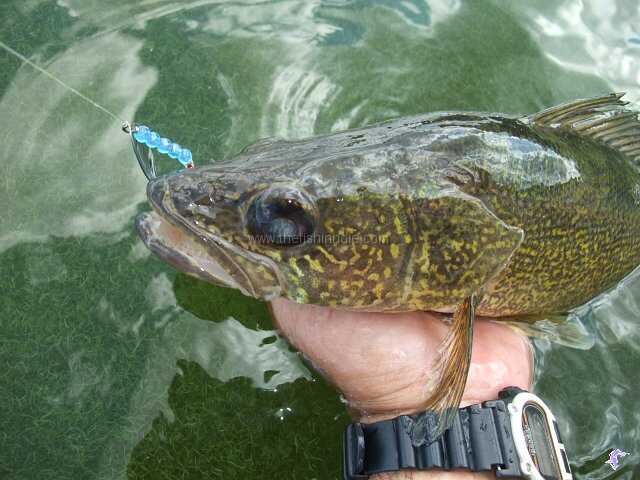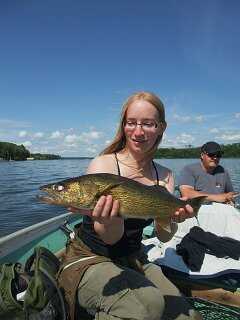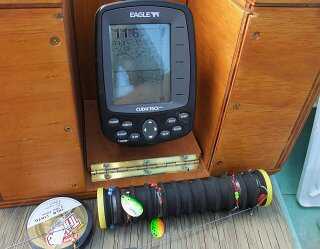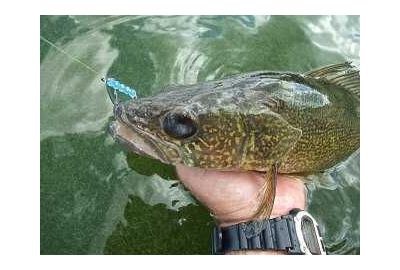

It was a hot sunny day, Baptiste Lake was in flood and neither I, Melanie or Trevor had any experience fishing this lake during the open water season. This could be a challenge. If there was one thing going for us, it was the undeniable fact that when it comes to fishing hot weather walleye, two things jump out at you. First, they’re crazy aggressive throughout the warm summer months and secondly they love edges. Putting the two together should mean some walleye on the line and fish in the cooler. At least that’s what we were hoping for as we each had retention tags for two Baptiste walleye.


If there is one great equalizer come summer trolling, it’s a depth sounder, but not for the obvious reason of ‘finding fish’. I’m not too interested in fish blips on the screen, because many things can give a false reading. A suspended chunk of algae in the water could send off the fish alarm signal. What I’m really interested in is what the bottom is doing.
At Baptiste there are emergent weedbeds visible around much of the shoreline that continue underwater beyond the depth we can see. This is where the sounder comes in handy.
It continued to show underwater weeds into the depths and on this day, the weeds stopped around the 12 foot mark. That was the bottom edge of the weedbeds and it was consistent throughout much of the lake. Then it was simply a matter of trolling in 12 to 14 feet of water with a bottom bouncer and spinner combo. This would theoretically put us somewhat close to that weed edge and in an area preferred by the lake’s walleye and pike. Several hours later on our way back to the boat launch we had run through four tubs of minnows and kept a couple fat walleye for the bbq back home. The edge effect worked for us this time.


Weeds aren’t the only edge that walleye relate to. On Calling Lake there’s an underwater contour that’s shaped like a boomerang and about the size of a hockey rink. The edge is set up by sharp differences in depth, with the shallow side being about 10 feet deep the other over 20. The sharp drop off combined with the sharp inside turn (the boomerang shape) creates a natural funnel for walleye and pike to move back and forth from shallow and deep. This is a spot that I troll through every summer on Calling and it has never disappointed. We’ve always caught fish there and it remains one of my best go to holes on the lake.


There is also a flat that’s probably 500 meters away that runs from 14 to 18 feet, but it’s a real mix of mud flat, then rock bottom, then mud flat, and rock bottom again. It’s easy to feel the differences in bottom composition, because of the sharp ticking being telegraphed up the rod when we run bottom bouncers over it. This spot has also been a walleye and pike factory and for some reason it typically produces the largest walleye day after day.
Now the really cool thing about the edge theory is that it continues to work in the winter. A productive drop off in summer will also be good come the hard water season. I took my friend Derek ice fishing to that mudflat drop off I talked about and he caught a 7 lb walleye followed by a 9 pounder on the same day. Lucky guy! The big difference come ice fishing season is that the low light of early morning and late evening become the most effective time to fish. That is, most of the bite will happen early and late, whereas in summer the bite can and often does last all day.
The edge effect is universal to most every lake. At Pigeon Lake come late winter I make my annual pilgrimage to the well known drop off out from the Provincial Campground. It’s something I do pretty much every February or March.


This too is a well defined edge and the fish have a pattern that’s as easy to follow as connecting the dots. During mid day, if there’s any bite happening, it’s normally toward the bottom edge of the drop, typically in 20 plus feet of water. As day shifts to evening, the walleye push up the slope and start to go on the feed. As the action heats up, the bite will become progressively shallower as they work their way up the slope. Nearing full night, much of the biting will be right at the top edge of the drop off until the fish have had their fill and the action dies off.
The best way to fish an edge in summer is to troll it. This covers water at a time when the fish are aggressive and active. It only makes sense to deliver a presentation that gets a hook in front of as many fish as possible. Because this is aggressive fishing, I put away the light tackle and run 10 pound Fireline with 10 pound mono as a leader. This system works well and gives me the ability to handle pretty much any fish that hits.
Come winter everything slows down. I have to rely on the fish coming to me as there are obviously no trolling options through the ice. I then downsize both line and lure. I run four pound mono so it’s really hard for the fish to see. I don’t use a leader and bury a frozen minnow into a wide gapped one eighth ounce jig. This way I have a very light presentation that is easy for the walleye to pick up and inhale. This method has caught me a ton of walleye through the ice and what may be most surprising is how I actually fish it. I drop the rig to the bottom, reel it up a couple inches and leave it alone. For real! The only time I react is when I see the tell tale bend in the rod indicating it’s time to pick it up and reel them in.


I sure love fishing, be it summer or winter. Finding and fishing the edges, be it contour edges, weed edges, or changes in bottom composition is an excellent way to find and catch more fish



